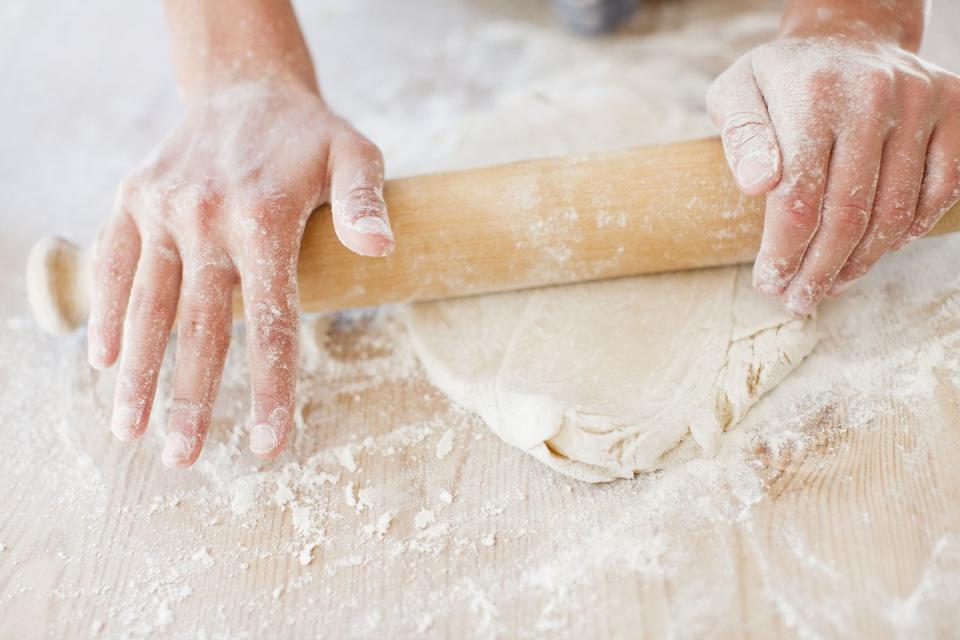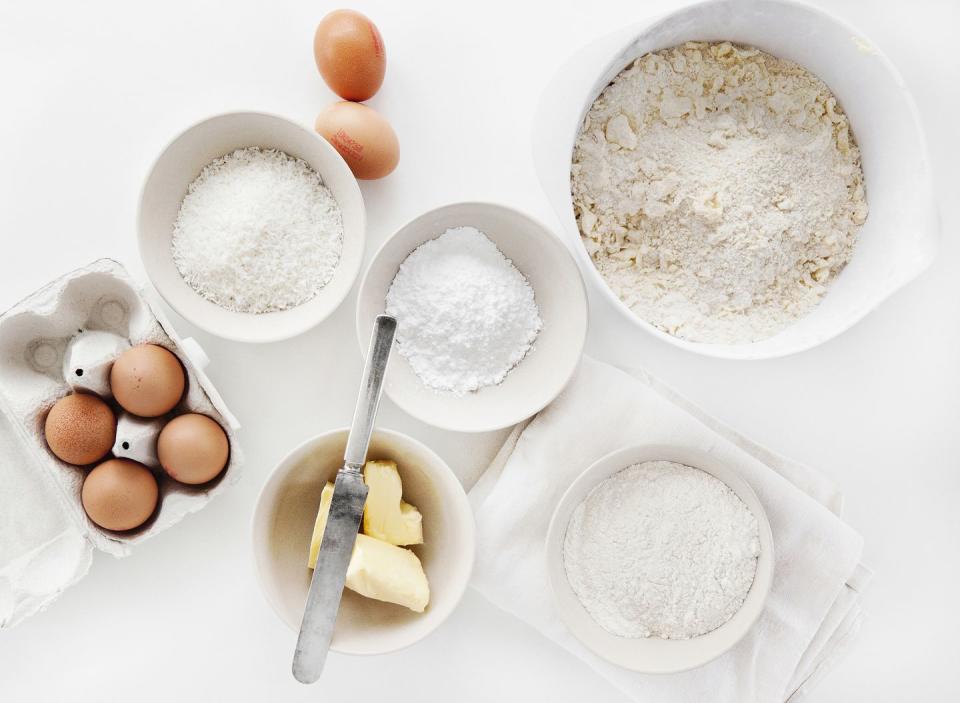Which Flour Should You Use? Get the Scoop on the 10 Most Popular Types

Baking is arguably the most scientific form of cooking. Not enough baking powder and your cakes could come out flat. Too much flour and your cookies might be rock solid. It’s enough to make you want to throw in the tea towel, so to speak.
While we’re willing to put a good amount of effort into our baking trials (after all, even when the results aren't perfect they are usually delicious!), when there are 10 different types of flour staring you down in the grocery aisle, it’s easy to get a little intimidated. You may be asking yourself: Do I really need to use cake flour for my cakes? What’s the difference between whole wheat flour and white whole wheat flour? How many types of flour do I actually need in my pantry?
The primary difference between each type of flour is the protein content, which is determined by the type of wheat used to make it. Flour made from high-protein wheat varieties, called hard wheat, have 10 to 14 percent protein content. Those made from low-protein wheat varieties, called soft wheat or white wheat, have a 5 to 10 percent protein content.
More protein means more gluten, and more gluten means more strength. When it comes to baking, the amount of gluten is what determines the structure and texture of a baked good.
Now that we’ve had our science lesson for the day, let’s break it down a little further into the difference between the ten most popular types of flour.

All-Purpose Flour
All-purpose flour should be a staple in your kitchen. Created from a mixture of soft and hard wheat varieties, it has a moderate protein content of about 9 to 11 percent. As the most versatile flour, it’s capable of creating flaky pie crusts, chewy cookies, and fluffy pancakes. (It's also the flour used in the homemade tortillas recipe featured in the video at the top of this article.) If a recipe calls for “flour,” it most likely means all-purpose flour.
A note on "bleached" vs. "unbleached": All-purpose flours that are labeled either "bleached" or "unbleached" will work wherever AP flour is called for. The main difference between these two types is in how they are produced. All flours will bleach (i.e. lighten) over time with exposure to air. Ones that are allowed to bleach naturally are labeled "unbleached." To speed up the process, manufacturers will add bleaching agents such as chlorine dioxide and benzoyl peroxide— these flours are labeled "bleached."
Best Used For: Cookies, muffins, bread, pie crusts, pancakes, biscuits, pizza dough, and pasta.
Cake Flour
Cake flour has the lowest protein content of all flours at 5 to 8 percent. Because of this, it forms less gluten, which leads to softer baked goods—perfect for cake recipes (obviously!), muffins, and biscuits. Cake flour also absorbs more liquid and sugar than all-purpose flour, which helps create super-moist cakes.
Best Used For: Sponge cake, pound cake, layer cakes, angel food cake, and muffins.
Pastry Flour
With an 8 to 9 percent protein content, pastry flour falls in between all-purpose flour and cake flour. It strikes the perfect balance between flakiness and tenderness, making it the go-to choice for pie crusts, tarts, and cookies. You can even make your own at home by mixing 1 1/3 cups of all-purpose flour with 2/3 cup cake flour.
Best Used For: Pie crusts, cookies, muffins, pancakes, cakes, biscuits, and bread sticks.

Bread Flour
Milled entirely from hard wheat, bread flour is the strongest of all flours with a high protein content at 12 to 14 percent. This comes in handy when baking yeasted breads because of the strong gluten content required to make the bread rise properly. Bread flour makes for a better volume and a chewier crumb with your bakes.
Best Used For: Artisan breads, yeast breads, bagels, pretzels, and pizza dough.
Self-Rising Flour
The secret ingredients of self-rising flour are the baking powder and salt added during the milling process. It’s generally made from soft wheat with a protein content around 8 to 9 percent. You can make your own at home by mixing 1 cup pastry flour with 1 ½ teaspoons baking powder and ¼ teaspoon salt. Be careful not to substitute self-rising flour for other flours while baking! The added ingredients can throw off the rest of the measurements in your recipe.
Best Used For: Pancakes, biscuits, and scones.
Whole Wheat Flour
During the milling process, a kernel of wheat is separated into its three components: the endosperm, the germ, and the bran. To make white flour, just the endosperm is milled. To make whole wheat flour, varying amounts of the germ and bran are added back in to the flour. Whole wheat flour tends to have a high protein content around 13 to 14 percent, but the presence of the germ and bran affect the flour’s gluten-forming ability. Because of this, whole wheat flour usually leads to super sticky dough and denser baked goods. The presence of wheat germ also makes whole wheat flour far more perishable than white flour. While white flour can sit in your pantry in an airtight canister for up to eight months, whole wheat flour will only stay at its best for up to three months.
Best Used For: Cookies, bread, pancakes, pizza dough, and pasta.
White Whole Wheat Flour
Not to be confused with bleached flour, white whole wheat flour is made up of the same components as whole wheat flour, but from a paler variety of wheat called hard white wheat. It has the same protein content as whole wheat flour at 13 to 14 percent, but it tastes slightly sweeter because of its lower tannin content. Whole wheat flour and white whole wheat flour actually have the same health benefits, so if you prefer the taste and texture of white bread, but want the nutritional value from whole wheat, then this is the flour for you.
Best Used For: Bread, muffins, pizza dough, and cookies.
Gluten-Free Flour
Gluten-free flour can be made from all sorts of ingredient bases, such as rice, corn, potato, tapioca, buckwheat, quinoa, sorghum, or nuts. Xanthan gum can sometimes be added to gluten-free flour to help stimulate the chewiness associated with gluten. Gluten-free flour can’t always be substituted 1:1 for white flour, so be sure to check your specific recipe if you’re thinking about swapping the two.
Best Used For: Cakes, cookies, pancakes, bread, and muffins.
Almond Flour
Almond flour is made by blanching almonds in boiling water to remove the skins, then grinding and sifting them into a fine flour. This gluten-free favorite is low in carbs and high in healthy fats and fiber. To replace wheat flour with almond flour, start by replacing the flours 1:1 and then add more of a rising agent (like baking powder or baking soda) to accommodate the heavier weight of the almond flour. Note: This will take a little experimenting.
Best Used For: Cookies, muffins, pancakes, biscuits, and bread.
00 Flour
Often referred to as Italian-style flour, 00 flour is made from the hardest type of wheat with a protein content of 11 to 12 percent. The “00” refers to the super-fine texture of the flour, making it easy to roll out to extreme thinness without breaking, which is perfect for pasta and crackers.
Best Used For: Pasta, couscous, thin crust pizza dough, flatbreads, and crackers.
You Might Also Like

